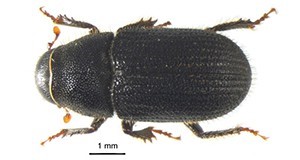Abstract
Black turpentine beetles bore into the inner bark of stressed or injured pines, where they breed and feed on phloem tissue. Adults are strongly attracted to volatile pine odors and readily breed in fresh stumps. In typical forests, infestations do not exhibit the rapid and devastating expansion characteristic of the closely related southern pine beetle, but in stands where stress conditions are frequent or persistent, black turpentine beetle can become a chronic pest and cause significant mortality over an extended period of time. Historically, black turpentine beetle has been a major pest of pines wounded or treated with herbicides in naval stores production. During the 1950s, black turpentine beetle damaged 37 million board feet of timber and contributed to the financial collapse of turpentine farms. This revised 5-page fact sheet was written by Albert E. Mayfield, John L. Foltz, and Jiri Hulcr, and published by the UF Department of Entomology and Nematology, June 2015. (Photo credit Adam Black and Jiri Hulcr, UF/IFAS)
References
Barnard EL. 1999. Annosum Root Rot of Pines in Florida. Plant Pathology Circular No. 398, Florida Department of Agriculture and Consumer Services, Division of Plant Industry, Gainesville. 5 p.
Barras SJ, Perry T. 1971. Leptographium terebrantis sp. nov. associated with Dendroctonus terebrans in loblolly pine. Mycopathologia et Mycologia applicata 43:1-10. https://doi.org/10.1007/BF02051496
Dixon WN. 1986. Black turpentine beetle. Florida Department of Agriculture and Consumer Services, Division of Forestry, Gainesville. Forest and Shade Treet Pest Leaflet No. 4.
Fatzinger CF. 1985. Turpentine-baited traps capture black turpentine beetles and other forest Coleoptera but do not prevent attacks on pines. pp. 26-31. In Branham SJ, Thatcher RC. (eds.). Integrated pest management symposium: the proceedings. April 15-18, 1985. Asheville, NC. USDA Forest Service, Southern Forest Experiment Station. General Technical Bulletin SO-56.
Godbee JF, Franklin RT. 1976. Attraction, attack patterns and seasonal activity of the black turpentine beetle. Annals of the Entomological Society of America 69: 653-655. https://doi.org/10.1093/aesa/69.4.653
Goldman SE, Cleveland GD, Parker JA. 1979. Lightwood induction and associated beetle attacks on slash pine. Forest Science 25: 80-83.
Goyer RA, Lenhard GJ, Nebeker TE, Jarrard LD. 1980. How to identify common insect associates of the southern pine beetle. Southern Pine Beetle Handbook. United States Department of Agriculture, Combined Forest Pest Research and Development Program. Agriculture Handbook No. 563.
Merkel EP. 1981. Control of the black turpentine beetle. Georgia Forest Research Paper No. 15.
Rane KK, Tattar TA. 1987. Pathogenicity of blue-stain fungi associated with Dendroctonus terebrans. Plant Disease 71: 879-883. https://doi.org/10.1094/PD-71-0879
Smith MT, Salom SM, Payne TL. 1993. The southern pine bark beetle guild: an historical review of the research on the semiochemical-based communication system of the five principle species. Virginia Agricultural Experiment Station, Bulletin No. 93-4. Blacksburg, VA. 106 p.
Smith RH, Lee, III RE. (1972). Black turpentine beetle. USDA Forest Service. Forest Pest Leaflet 12. (30 March 2015).
Staeben J, Clarke S, Gandhi K. 2010. Forest insect and disease leaflet 12: Black turpentine beetle. USDA Forest Service, Pacific Northwest Region (R6), Portland, Oregon.
USDA Forest Service. 1985. Insects of Eastern Forests. Misc. Publication No. 1426. Washington, DC. 608 p.
Wood SL. 1982. The bark and ambrosia beetles of North and Central America (Coleoptera: Scolytidae), a taxonomic monograph. Great Basin Naturalist Memoirs. No. 6. 1359 p.

